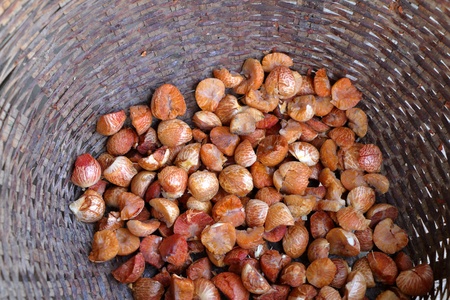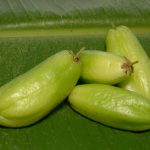
Betel nut or perhaps betel quid as it is more commonly known is regularly chewed by those as a recreational drug in various parts of Africa and Asia where the nut is grown. It’s been a part of folklore for millennia and vast quantities are chewed mainly as a masticatory to stimulate saliva flow. The nut is also regularly chewed at the same time as smoking which helps or hinders many of the effects of the nut.
In cultural occasions, the nut is a symbol of marriage in Vietnam and has been used by Indian royalty since the pre-Vedic period.
The species is Areca catechu and is more commonly known as Betel Palm.
The betel nut which is chewed regularly, is made up of three components: small pieces of nut, wrapped in a leaf of the Piper betle vine, limestone paste or powdered slaked lime. The lime addition is known as ‘paan’ . These are all chewed together.
The recreational nature of the chewing is to release psychoactive and stimulant compounds.
There is little evidence for any specific health or therapeutic benefits although it contains pharmacologically active components.
There have been warnings issued about the chronic chewing of betel nuts by the U.S. National Institutes of Health. The toxicity of the nut probably outweighs any benefits likely to come from this nut.
Componentry And Compounds In Betel Nut
The main active is an alkaloid called arecoline which has cholinomimetic effects and affects the parasympathetic system in many ways. The nut contains lesser amounts of the related alkaloid guvacoline and the amino acids arecaidine and guvacine. The addition of lime to the mix is to cause alkaline hydrolysis the arecoline to arecaidine. This reduces the side effects associated with arecoline such as causing tremor, salivation and dribbling.
Studies in mice have demonstrated that arecaidine is a type of tetrahydronicotinic acid derivative. One of these derivatives is nipecotic acid, or ‘hexahydronicotinic acid’, which is a potent inhibitor of the uptake of the central inhibitory transmitter γ-aminobutyric acid (GABA). It is thought that the psychic effects of betel nut consumption is due to the result of inhibition of GABA uptake (Johnstone et al., 1975).
Masticatory And Saliva-Producing Benefits
Chewing the betel nut leads to excessive production of saliva. This has been used by some to overcome dry mouth caused by diabetes, some cancers and Sjogren’s syndrome.
Mental Illnesses (Schizophrenia)
Drugs treating schizophrenia in general are highly unpleasant and cause Parkinson’s-type symptoms over long periodic use. The desire to use less aggressive drugs has led some to consider betel nut.
Some initial studies suggested patients with schizophrenia improved their cognitive and mental state when they chewed betel nut. However, the side effects were shakes and tremors and muscle stiffness. That investigation is still ongoing so as to identify the components that might regulate outflows from the cerebral cortex.
Cardiovascular Health And Stroke
Some indications from preliminary research suggest some measure of stroke recovery is possible with chewing betel nut. Whilst the research remains to be validated and there are issues with such studies, improvements in speech, reduction in slurring, improved control of the bladder and increased muscle strength and rigor have been observed.
Side Effects
One of the side effects is to exacerbate the effects of high and even low blood pressure. It is capable of generating arythmias or regular heart beat and inducing asthma in some.
Cancer Causing Issues
In countries like Papua New Guinea where there is chronic use of betel nut, so there is a high incidence of oral squamous cell cancer which is highly malignant. the cancer is concentrated in the corner of the mouth and cheek and was associated with the typical chewing positions for betel nut (Thomas and MacLennan, 1992). It is probably a result of the use of slaked lime which raises the pH of the product to above pH 10 is at the heart of the problem. This alkaline pH induces reactive oxygen species to form that lead to cell proliferation and damage.
Chewing betel nut also produces excess collagen production in the mouth leading to a condition known as oral submucous fibrosis (OSF) (Harvey et al., 1986).
Smoking And Betel Nut Chewing
Evidence from analysis of betel nut chewers who also smoke suggests they are highly prone to upper alimentary tract cancers due to the presence of N-nitroso compounds. Whilst smoking produces these dangerous chemicals, the compounds in betel nut also become adversely modified leading to the formation of N-nitrosoguvacoline and N-nitrososoguvacine. As well as N-nitroso products simply from smoking, there is a likely damaging impact from these additional compounds.
Discoloration Of Teeth
Nut chewers are recognised by the highly stained and black discoloured teeth which is also permanent. When handled regularly, betel nut may stain the hands.
References
Johnston, G. A. R., Krogsgaard-Larsen, P., & Stephanson, A. (1975). Betel nut constituents as inhibitors of γ-aminobutyric acid uptake. Nature, 258(5536), pp. 627-628
Nair, J., Ohshima, H., Friesen, M., Croisy, A., Bhide, S. V., & Bartsch, H. (1985). Tobacco-specific and betel nut-specific N-nitroso compounds: occurrence in saliva and urine of betel quid chewers and formation in vitro by nitrosation of betel quid. Carcinogenesis, 6(2), pp. 295-303
Thomas, S. J., & MacLennan, R. (1992). Slaked lime and betel nut cancer in Papua New Guinea. The Lancet, 340(8819), pp. 577-578

Leave a Reply